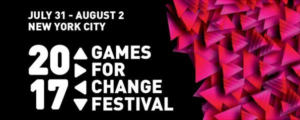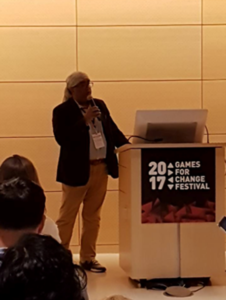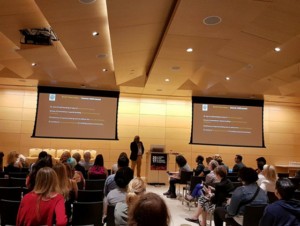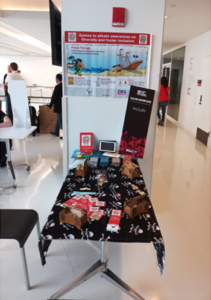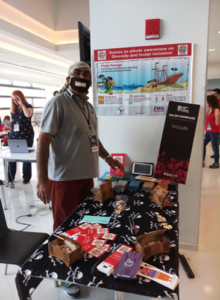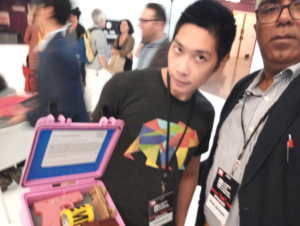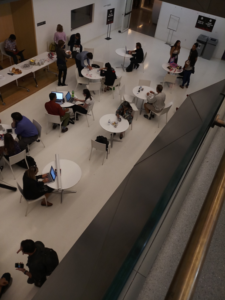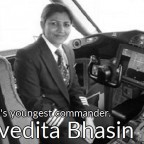By Garry Williams, Vincent Ducos, Jesse Himmelstein
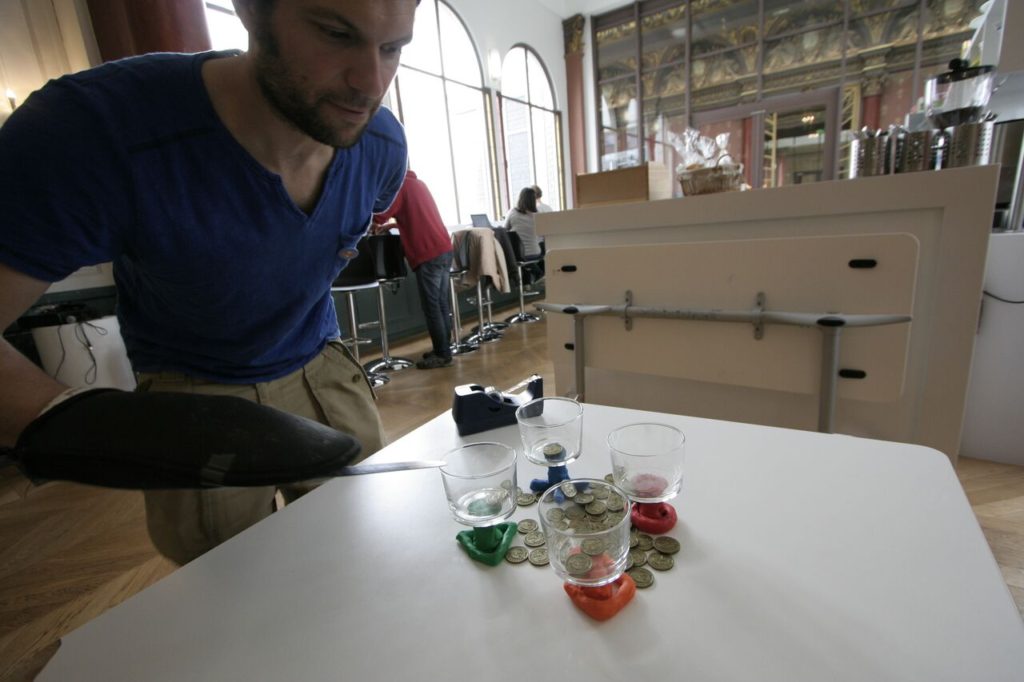
Find the game at https://github.com/CyberCRI/PiratePartage
Pirate Partage was created during the Diversity Jam that was hosted by IncLudo, CRI, JamShaker, Games4Change Europe, and Mozilla Paris. It started with a pitch from Garry for an idea where players assume physical handicaps and must accomplish something together, and grew into a silly physical card-based game that is as fun to play as it is to watch.
Vincent and I were into the idea, and teamed up with Garry just after the pitching session. I was excited by the opportunity to work on a physical game rather than a video game during the jam, both for variety and for the speed with which you can try out new ideas when you don’t have to program and draw each one. Indeed, we were able to go really fast. The three of us actually completed two different games during the jam, and experimented with a few other designs that we then dropped. Even better, we were able to playtest and tune the games quite a few times, something that I’ve never had the luxury of doing during a jam before.
In this blog post, I try to recount the evolution of our idea and the reasons behind of changes in direction. Since ideas can be so ephemeral, I’m certainly forgetting many of them.
Version 1: Rhythm
So, we had the idea for a physical game about handicaps, but didn’t know what the players were actually doing. Garry suggested that we use Makey-Makeys, which sounded like a lot of fun. Maybe we could make a rhythm game in which the players have to work together but one player is blind and the other deaf? Let’s test it!
For our test, we put colored circle stickers on cards that represented the different sequences of “notes” that the players had to enter. Then bought a bunch of modeling clay that we shaped into the “buttons” that the players would need to press in sequence (Note: it turned out only certain modeling doughs conduct electricity, and this was not one of them. What a huge pain! We followed online instructions about mixing it salt water or graphite, but nothing worked. So we ended up wrapping it in tinfoil, which was very fragile, and pretty ugly too.).
At this point we had found some cool props for our handicaps. The physically-handicapped wore a big oven mitt, making it pretty hard to manipulate objects. The deaf player wore headphones, and Garry put on music to make it impossible to hear (also it’s fun to have a personal soundtrack to a game). I always carry travel masks, which are perfect for covering both eyes. Not much for the mute player, unfortunately.
We had one player teach the other the sequence, using whatever means they could while respecting the handicaps. So for example the deaf player would look at the card and try to teach it to the bind player through moving their hands or drawing on their skin. From the outside, this part was pretty fun to watch. But as a player, it was really difficult to memorize the sequences. And not in a fun way.
Version 2: Swap
Maybe we could do away with the memorization part and just have one player indicate to the other in real-time what they needed to do? We made a bunch of cards indicating which buttons had to be pressed. One player would draw a card with the instructions, and had to get the other player to press them. Rather than keeping the rhythm, the goal became drawing the cards and executing the actions as quickly as possible. This aspect of the game was heavily inspired by Spaceteam.
At this point, we had figured out that even though the blind player couldn’t use color as an indicator of which button to press, they could feel out the shape of the buttons. So we paired colors and basic geometric shape together on the buttons: red circle, green triangle, etc.
This version was easier and faster than the previous one. But pressing one button was a bit too easy. We tried pressing 2 buttons at once. We tried picking up the two shapes and then putting them down again. And then came a more exciting idea: what if instead of pressing buttons, we picked up two shapes and swapped their positions?
Since the Makey-makey part wasn’t working well anyway, we could drop the constraint that it had to be convertible into a video game. And swapping the shapes made it harder for another player to simply memorize the positions of the objects. We tried it with 4 players, where each player was drawing from their own stack of cards and playing at the same time as everyone else. It was fun to watch the players try to negotiate who was moving first, especially since the blind player couldn’t just glance at the table to see the positions of the objects.
We playtested with other jammers. It was fun to watch. Time for lunch!
Lunch break
Over some bò búns and beer, we talked over what we had made. There was one glaring problems with our idea- what possible reason could we give to the players that would explain why they had to swap the objects? What context, story, theme, or other meaning could we give that would have this strange act make sense?
One of us had the idea of transforming the mode of the game from collaboration to competition. What about if you had to barter to exchange items? This communication would be more interesting, and bring in a strategic element of deciding which player to barter with and under what conditions. Also, it would be easier to come up with a story that explained what the players were doing and why.
Version 3: Barter
Freshly back from lunch, we set out testing the idea. We gave each player tokens of different colors. We made “objective” cards that spelled out what combination of tokens each player needed. And off we went.
It was no fun, though. In fact, it turned out to be relatively easy to barter with another player, because there wasn’t that much information to exchange. And so if one player could just monopolize the conversation long enough to make 2 or 3 trades, they would win. Plus, it was harder for certain players to communicate than for others. In particular, the blind player was at a significant disadvantage both for capturing another players attention and for keeping track of who had which tokens.
So this idea seemed like a dead-end. But the bartering made us think of another variant. What if we paid each other coins instead of swapping objects?
Version 4: Pay me
We returned to our collaborative system, but instead of telling players to swap objects, the cards instructed a player exchange 2 coins with the neighbor on their left, for example.
When we tested it, we found that counting the coins was fun for the blind player. But we had gotten rid of the contention around the objects at the center of the table, which was a shame. And what reason could we come up with for swapping coins with each other, anyway?
This is when someone came up with a really cool theme: pirates!
Version 5: Pirates
Here’s the story: a bunch of pirates have to share some treasure. There are a bunch of treasure chests in the middle of the table, in different shapes and colors, as well as a pile of treasure (coins). The goal is for each pirate to get the others to place the right number of coins in the right treasure chest, as quickly as possible.
There were a few nice consequences to this idea. First, we finally had a theme. And one that allowed us to associate each handicap to a pirate character. The blind pirate was the one with the familiar eye patch (well, two patches actually). The deaf pirate became so because he was in charge of lighting the cannons. The best of all, the one with the physical handicap had a hook for a hand (we didn’t have an actual hook, so we took a coffee stirrer and taped it to the oven mitt). The deaf one wasn’t as obvious, but at least we could draw a big pirate smile with missing teeth and drape it over the player’s mouth.
Also, we returned to the nice dynamic of contention around the objects in the center of the table. Since we couldn’t find actual treasure chests, we used glasses from the Mozilla kitchen and formed bases out of modeling dough. Occasionally the glasses would fall over, but that turned out to be fun too.
We loved how Spaceteam throws in occasional actions that require the attention of all the players. We came up with two such ideas for our own game. If any player draws a “toast” card, all the pirates must put their hands together in a mock rum toast over the table. And a “swap handicaps” card makes it so that you have to change identities in the game. This complicates things both for the players who have to assume new constraints, and for the other players who have to suddenly exchange communication styles with them.
Version 6: Production
Up until now we were using hand-written cards, but we wanted something more polished for the demo at the end of jam. After a bit of searching, we found a program called nanDECK. It only runs on Windows, and I couldn’t call its interface pretty or intuitive, but it turns out to be just fantastic for making card games.
The big advantage of using nanDECK is that you can specify graphical elements like text and images over ranges of cards. So for example, you can tell it to put a left arrow at position (0, 100) on cards 1 through 30, and the number “2” on cards 1, 3, 5, 7, etc. It generates a PDF that you can print, cut, and paste yourself. No more copying and pasting in a document or image editor!
Vincent made the graphics and designed the cards. About 15 minutes of cutting and taping later, we had a pretty new deck!
Oh, and we came up with a name. “Partage” means “sharing” in French, and “pirate” is the same in both languages. So “Pirate Partage” sounds cool, even if it doesn’t mean much in English.
Future
There’s one aspect that we talked a lot about but never got around to doing: braille cards. Right now the blind player has to “cheat” and peek at their cards in order to understand them. We’d like to make the cards in such a way that they can be “read” by the blind pirate using touch alone. To do that, we would like to either draw on the cards with some kind of thick substance, poke holes in the cards, or put a second layer of card stock on top.
Reflection
When you make a game where players assume handicaps, there’s the danger that someone could mistake your intentions. We are most certainly not trying to make fun of someone who can’t speak, hear, or pick things up with their hands. Nor are we truly “simulating” what it would be like to have such handicaps, because in real life people adjust to their abilities and work around them in incredible ways. For example, an actual deaf person would probably just read lips, if not use sign language.
When you think about it, a great number of fantastic games are based on imposing artificial limitations on players. Look at soccer, which is essentially a game about manipulating a ball when you can’t you use hands. Pirate Partage is in the lineage of miming, drawing, and guessing games which limit the means of communication for amusement.
So does this game say anything about diversity? I don’t think it will directly inspire organizations to hire people with disabilities. But I do hope that it could be used to spark conversations about ways to communicate. When faced with a communication barrier, people are remarkably good at finding ways around it- think about how you might order food in a foreign restaurant, for example, when you can’t speak the language. Though it takes more effort at first, communicating in unconventional ways can be just as effective, while being way more enriching.
Find the game at https://github.com/CyberCRI/PiratePartage


